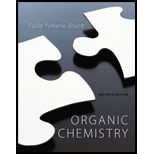
(a)
Interpretation:
Mechanism for the given reaction should be proposed.
Concept Introduction:
Unimolecular nucleophilic substitution reaction in which the reversible ionization of
If the leaving group in
An enantiomer, also known as an optical isomer, is one of two stereoisomers that are mirror images of each other that are non-superimposable.
(b)
Interpretation:
The formation of two products in the given reaction should be explained.
Concept Introduction:
Unimolecular nucleophilic substitution reaction in which the reversible ionization of alkyl halide in the presence of aqueous acetone or an aqueous ethyl alcohol provides a carbocation as an intermediate, attacked by the nucleophile to form the product.
If the leaving group in
An enantiomer, also known as an optical isomer, is one of two stereoisomers that are mirror images of each other that are non-superimposable.
(c)
Interpretation:
Reason for the single substation products obtained in the given reaction should be explained.
Concept Introduction:
Unimolecular nucleophilic substitution reaction in which the reversible ionization of alkyl halide in the presence of solvent provides a carbocation as an intermediate, attacked by the nucleophile to form the product.
If the leaving group in
An enantiomer, also known as an optical isomer, is one of two stereoisomers that are mirror images of each other that are non-superimposable.
Want to see the full answer?
Check out a sample textbook solution
Chapter 9 Solutions
Organic Chemistry
 Organic Chemistry: A Guided InquiryChemistryISBN:9780618974122Author:Andrei StraumanisPublisher:Cengage Learning
Organic Chemistry: A Guided InquiryChemistryISBN:9780618974122Author:Andrei StraumanisPublisher:Cengage Learning
